ESTABLISHMENT OF THE 11th CAVALRY
2 February 1901
After attaining victory in the Spanish-American War of 1898, the United States found itself with the new task of Territorial Administration. In large part, the job fell to the regular Army. Found to be undermanned for the mission, Congress increased the standing army by five infantry and five cavalry Regiments. Thus, on 2 February 1901, the 11th Cavalry Regiment was the first of five newly formed cavalry regiments. The 12th, 13th, 14th and the 15th Cavalry Regiments followed.
On 11 March 1901, the first recruits of the new Regiment reported for training at Fort Myer, Virginia. A combat tested veteran of the Civil War, who also gave distinguished service in the Spanish-American War, was tasked with raising the Regiment and serving as its first commanding officer. The 11th Cavalry was exceptionally fortunate in having the standard set by such an experienced and resourceful officer as Colonel Francis Moore; FIRST COLONEL OF THE REGIMENT.
“I have 400 men who have never seen a horse, I have 400 horses who have never seen a man, and I have 15 Officers who have never seen a man or a horse.”
First training report rendered by the Major of the 3d Squadron,
15th Cavalry, as it was being organized on Mindanao, Philippine Islands, in 1901. This sentiment was fully shared throughout the newly formed 11th, 12th, 13th, 14th and 15th Cavalry regiments
2 February 1901
After attaining victory in the Spanish-American War of 1898, the United States found itself with the new task of Territorial Administration. In large part, the job fell to the regular Army. Found to be undermanned for the mission, Congress increased the standing army by five infantry and five cavalry Regiments. Thus, on 2 February 1901, the 11th Cavalry Regiment was the first of five newly formed cavalry regiments. The 12th, 13th, 14th and the 15th Cavalry Regiments followed.
On 11 March 1901, the first recruits of the new Regiment reported for training at Fort Myer, Virginia. A combat tested veteran of the Civil War, who also gave distinguished service in the Spanish-American War, was tasked with raising the Regiment and serving as its first commanding officer. The 11th Cavalry was exceptionally fortunate in having the standard set by such an experienced and resourceful officer as Colonel Francis Moore; FIRST COLONEL OF THE REGIMENT.
“I have 400 men who have never seen a horse, I have 400 horses who have never seen a man, and I have 15 Officers who have never seen a man or a horse.”
First training report rendered by the Major of the 3d Squadron,
15th Cavalry, as it was being organized on Mindanao, Philippine Islands, in 1901. This sentiment was fully shared throughout the newly formed 11th, 12th, 13th, 14th and 15th Cavalry regiments
PHILIPPINE ISLANDS(Philippine Campaign Medal)
By June 1901, the Regiment was fully activated, although its three Squadrons were separated to posts in Missouri, Vermont and Virginia. Six months of intensive training culminated with orders to depart for the Philippines to assist in putting down the insurrection there. First Squadron traveled overland and embarked out of San Francisco to Hawaii, Wake Island and then on to the Philippines. Second and Third Squadrons left by way of New York on the U.S.A.T. Buford* (Army Transport Service), arriving in Manila after a sixty-one day voyage which included passage through the Suez Canal.
[*General John Buford, 1848 - 1863, West Point Class of 1848, Civil War US Cavalry commander. He led the Union forces in the epic 14-hour Battle of Brandy Station 9 June 1863. In this, the largest cavalry action in the Western Hemisphere, the classic saber and pistol clash involved a total of over 17,000 horse-mounted troopers. He fought the Confederate Cavalry to a draw for the first time in the Civil War in an action that began the rise to dominance of the Union horsemen. At Gettysburg, the battle that saw more Americans die than any other in history, he dismounted his 2500 troopers and held off a Confederate Division for over two hours until reinforcements arrived. This action stopped the Confederate advance and forced the battle onto ground of his own choosing.]
Future President William Howard Taft was the First Civil Governor of the Philippines and his governorship of the islands was a high mark in colonial administration for any nation. He had First Squadron dispatched to Samar, Second Squadron to Batangas Province, and Third Squadron to northern Luzon. Experiencing jungle warfare for the first time, the Regiment fought dismounted. The name of Private Clarence L. Gibbs, KIA 4 March 1902, was the first to be placed on the 11th Cavalry Roll of Honor.
By May 1902, working from satellite camps attached to larger base camps, daily patrols of Troopers had swept the countryside of guerrillas and the Regiment began the transition to garrison operations. The tropical climate, illness and guerrilla warfare had depleted the Regiment to one-third strength.
Orders home were issued in March 1904 and within a month, the Regiment was scattered around the United States once more. HQ and Second Squadron were at Ft. Des Moines, Iowa; First Squadron was assigned to the historic cavalry post at Ft. Riley, Kansas; Third Squadron was split between Ft. Sheridan, Illinois and Jefferson Barracks, Missouri. It was not until summer 1905 that the Regiment served together for the first time when it was consolidated at Ft. Des Moines.
By June 1901, the Regiment was fully activated, although its three Squadrons were separated to posts in Missouri, Vermont and Virginia. Six months of intensive training culminated with orders to depart for the Philippines to assist in putting down the insurrection there. First Squadron traveled overland and embarked out of San Francisco to Hawaii, Wake Island and then on to the Philippines. Second and Third Squadrons left by way of New York on the U.S.A.T. Buford* (Army Transport Service), arriving in Manila after a sixty-one day voyage which included passage through the Suez Canal.
[*General John Buford, 1848 - 1863, West Point Class of 1848, Civil War US Cavalry commander. He led the Union forces in the epic 14-hour Battle of Brandy Station 9 June 1863. In this, the largest cavalry action in the Western Hemisphere, the classic saber and pistol clash involved a total of over 17,000 horse-mounted troopers. He fought the Confederate Cavalry to a draw for the first time in the Civil War in an action that began the rise to dominance of the Union horsemen. At Gettysburg, the battle that saw more Americans die than any other in history, he dismounted his 2500 troopers and held off a Confederate Division for over two hours until reinforcements arrived. This action stopped the Confederate advance and forced the battle onto ground of his own choosing.]
Future President William Howard Taft was the First Civil Governor of the Philippines and his governorship of the islands was a high mark in colonial administration for any nation. He had First Squadron dispatched to Samar, Second Squadron to Batangas Province, and Third Squadron to northern Luzon. Experiencing jungle warfare for the first time, the Regiment fought dismounted. The name of Private Clarence L. Gibbs, KIA 4 March 1902, was the first to be placed on the 11th Cavalry Roll of Honor.
By May 1902, working from satellite camps attached to larger base camps, daily patrols of Troopers had swept the countryside of guerrillas and the Regiment began the transition to garrison operations. The tropical climate, illness and guerrilla warfare had depleted the Regiment to one-third strength.
Orders home were issued in March 1904 and within a month, the Regiment was scattered around the United States once more. HQ and Second Squadron were at Ft. Des Moines, Iowa; First Squadron was assigned to the historic cavalry post at Ft. Riley, Kansas; Third Squadron was split between Ft. Sheridan, Illinois and Jefferson Barracks, Missouri. It was not until summer 1905 that the Regiment served together for the first time when it was consolidated at Ft. Des Moines.
CUBAN PACIFICATION
(Army of Cuban Pacification Medal 1906-09)
The Cuban republic was established after the 1898 Spanish-American War. In 1901 the Platt Amendment, a rider attached to the Army Appropriations Bill of 1901, stipulated the conditions for U.S. intervention in Cuba that virtually made the island an U.S. protectorate. Under the terms of this bill the United States established – and retains to this day – a naval base at Guantanamo Bay.
In mid-1906 Cuban internal strife caused the United States to invoke the Platt Amendment and send troops to the island nation in an attempt to restore order. William Howard Taft, now Secretary-of-War, sent his Philippine Insurrection veterans, the experienced 11th Cavalry Regiment under the command of Colonel Earl D. Thomas, 2nd COLONEL OF THE REGIMENT.
Pulled from its annual maneuvers at Fort Riley, Kansas, First Squadron returned to Fort Des Moines while the balance of the regiment left for Cuba by way of Newport News. The regiment arrived in Havana ahead of its horses on 16 October 1906 and set up base camp outside the city. A storm with hurricane force winds struck the next day, destroying the camp and battering the ships still at sea so badly that over 200 mounts were killed. The troopers of the day quickly recovered and assumed control of western Cuba. Regimental Headquarters was established in Pinar del Rio after a 29 hour/110 mile force march by Troop F. The mission of the 11th Cavalry was to 'show the flag' by conducting mounted patrols throughout the countryside between the villages. While in Cuba the regiment was joined by its new commander, Colonel James Parker, 3rd COLONEL OF THE REGIMENT.
"Galloping Jim" (the longest serving Colonel) continued peacekeeping operations during the Regiment's two-year stay, demonstrating to the natives that the US Army's Cavalry was ready for any and all eventualities. Although conflict is at times inevitable, the 11th Cavalry Regiment best serves the country when it commands respect and thereby averts war through a show of strength. This will be repeated time and again throughout the history of the regiment.
By 1909, the political situation in Cuba was stable and the regiment was recalled. In late February, they began hurried preparations to embark out of Havana and return to the United States. The reason for the hasty departure became apparent when, upon arriving once again in Newport News, Virginia on 1 March 1909, they were immediately ordered to Washington D.C. by train. Arriving in a severe blizzard, the troopers of the 11th Cavalry Regiment nonetheless readied them selves for the task at hand. The next day, 4 March 1909, the Blackhorse assumed a place of honor in the inaugural parade of their old friend and now President, William Howard Taft.
After the inauguration of President Taft, the regiment settled into garrison life at its new home at Fort Oglethorpe, Georgia. The reprieve was short lived however, as in early 1911 the regiment was deployed to the Texas/Mexico border in response to Mexico's internal political turmoil, which threatened to spill into the United States. This would prove to be the first of many border postings for the 11th Cavalry. The crisis soon eased and the regiment returned to Fort Oglethorpe in November.
(Army of Cuban Pacification Medal 1906-09)
The Cuban republic was established after the 1898 Spanish-American War. In 1901 the Platt Amendment, a rider attached to the Army Appropriations Bill of 1901, stipulated the conditions for U.S. intervention in Cuba that virtually made the island an U.S. protectorate. Under the terms of this bill the United States established – and retains to this day – a naval base at Guantanamo Bay.
In mid-1906 Cuban internal strife caused the United States to invoke the Platt Amendment and send troops to the island nation in an attempt to restore order. William Howard Taft, now Secretary-of-War, sent his Philippine Insurrection veterans, the experienced 11th Cavalry Regiment under the command of Colonel Earl D. Thomas, 2nd COLONEL OF THE REGIMENT.
Pulled from its annual maneuvers at Fort Riley, Kansas, First Squadron returned to Fort Des Moines while the balance of the regiment left for Cuba by way of Newport News. The regiment arrived in Havana ahead of its horses on 16 October 1906 and set up base camp outside the city. A storm with hurricane force winds struck the next day, destroying the camp and battering the ships still at sea so badly that over 200 mounts were killed. The troopers of the day quickly recovered and assumed control of western Cuba. Regimental Headquarters was established in Pinar del Rio after a 29 hour/110 mile force march by Troop F. The mission of the 11th Cavalry was to 'show the flag' by conducting mounted patrols throughout the countryside between the villages. While in Cuba the regiment was joined by its new commander, Colonel James Parker, 3rd COLONEL OF THE REGIMENT.
"Galloping Jim" (the longest serving Colonel) continued peacekeeping operations during the Regiment's two-year stay, demonstrating to the natives that the US Army's Cavalry was ready for any and all eventualities. Although conflict is at times inevitable, the 11th Cavalry Regiment best serves the country when it commands respect and thereby averts war through a show of strength. This will be repeated time and again throughout the history of the regiment.
By 1909, the political situation in Cuba was stable and the regiment was recalled. In late February, they began hurried preparations to embark out of Havana and return to the United States. The reason for the hasty departure became apparent when, upon arriving once again in Newport News, Virginia on 1 March 1909, they were immediately ordered to Washington D.C. by train. Arriving in a severe blizzard, the troopers of the 11th Cavalry Regiment nonetheless readied them selves for the task at hand. The next day, 4 March 1909, the Blackhorse assumed a place of honor in the inaugural parade of their old friend and now President, William Howard Taft.
After the inauguration of President Taft, the regiment settled into garrison life at its new home at Fort Oglethorpe, Georgia. The reprieve was short lived however, as in early 1911 the regiment was deployed to the Texas/Mexico border in response to Mexico's internal political turmoil, which threatened to spill into the United States. This would prove to be the first of many border postings for the 11th Cavalry. The crisis soon eased and the regiment returned to Fort Oglethorpe in November.
LUDLOW MASSACRE
In May 1914, the 11th Cavalry found itself on the go again, this time to Colorado. A violence-marred coal strike had culminated in the so-called Ludlow Massacre in which several miners along with two women and eleven children were killed in the small town of Trinidad. Secretary of War Lindley M. Garrison dispatched the Regiment to perform the difficult and delicate task of restoring order to a community torn by rioting in the wake of the massacre. It was even more frustrating for our troopers considering many came from the coal mining villages of West Virginia and they knew what life is like working under these conditions. The troopers of the 11th Cavalry performed their sensitive mission well, winning praise for their “poise, justness, absolute impartiality, and effectiveness.” The Regiment returned to Georgia in January 1915 for a stay of a little over a year.
In May 1914, the 11th Cavalry found itself on the go again, this time to Colorado. A violence-marred coal strike had culminated in the so-called Ludlow Massacre in which several miners along with two women and eleven children were killed in the small town of Trinidad. Secretary of War Lindley M. Garrison dispatched the Regiment to perform the difficult and delicate task of restoring order to a community torn by rioting in the wake of the massacre. It was even more frustrating for our troopers considering many came from the coal mining villages of West Virginia and they knew what life is like working under these conditions. The troopers of the 11th Cavalry performed their sensitive mission well, winning praise for their “poise, justness, absolute impartiality, and effectiveness.” The Regiment returned to Georgia in January 1915 for a stay of a little over a year.
FOOD FOR MARCHING ORDER
The menu of the troops must not be forgotten. In every game of chance, there is always a possible element of disappointment, but there is neither chance nor disappointment in the matter of meals for troops. They were dealt the inevitable "government straight" consisting of canned baked beans, canned tomatoes, canned corn bread ("Corned Willie"), coffee and prunes. This may not sound so bad, but it did get monotonous.
The menu of the troops must not be forgotten. In every game of chance, there is always a possible element of disappointment, but there is neither chance nor disappointment in the matter of meals for troops. They were dealt the inevitable "government straight" consisting of canned baked beans, canned tomatoes, canned corn bread ("Corned Willie"), coffee and prunes. This may not sound so bad, but it did get monotonous.
THE GREAT WAR
World War I began on 28 July 1914, one month after the assassination of the heir to the Austro-Hungarian throne by a Serbian terrorist in Sarajevo, Bosnia. The United States was not immediately drawn into "The Great War", as it was then known. American lives were lost however, during the sinking of the British liners Lusitanian and Arabic in May and August of 1915. After hostile reactions from American citizens and vehement protests from the U.S. Government, Germany announced the cessation of unlimited submarine war. Meanwhile, events much closer to home were commanding the attention of the 11th Cavalry.
World War I began on 28 July 1914, one month after the assassination of the heir to the Austro-Hungarian throne by a Serbian terrorist in Sarajevo, Bosnia. The United States was not immediately drawn into "The Great War", as it was then known. American lives were lost however, during the sinking of the British liners Lusitanian and Arabic in May and August of 1915. After hostile reactions from American citizens and vehement protests from the U.S. Government, Germany announced the cessation of unlimited submarine war. Meanwhile, events much closer to home were commanding the attention of the 11th Cavalry.
PUNITIVE EXPEDITION MEXICO - 1916 (Mexican Service Medal)
On 9 March 1916, the Mexican revolutionary "Pancho" Villa raided the town of Columbus, New Mexico. President Woodrow Wilson ordered Brigadier-General John J. "Black Jack" Pershing to lead a Punitive Expedition into Mexico to destroy Villa's rebel army. On 12 March the 11th Cavalry under the command of James Locket (4th COLONEL OF THE REGIMENT) was ordered to report to Pershing. The lead elements of the Regiment moved out that very night.
A feature of railroad troop trains is their ability for "rapid" transit. At every station stop, a delegation of the Red Cross met the trains with hot coffee and sweet smiles. At El Paso, Texas the 11th Cavalry was ordered to go directly to Columbus, New Mexico to join the expedition going into Mexico. Lieutenant-Colonel Henry T. Allen led First Squadron as the forward element into that country.
The Provisional Squadron of the 11th Cavalry was formed under the command of Major Robert L. Howze. On 10 April 1916, a Villista patrol engaged Major Howze’s advance guard. In the ensuing battle, the Regiment suffered its first casualties of the campaign with three wounded and Private Kirby of Troop M killed. Trooper Kirby was buried where he fell. The Regiment had forced marched for 21 days over 571 miles. Two troops (companies) of the 10th Cavalry, the "Buffalo Soldiers” reinforced the Regiment at Parral. Cut off from their base at Colonia Dublan, the squadron was sorely in need of re-supply. "Our animals were low in flesh. Officers had to watch their men to keep them from eating part of the corn allowance of the horses."
On 9 March 1916, the Mexican revolutionary "Pancho" Villa raided the town of Columbus, New Mexico. President Woodrow Wilson ordered Brigadier-General John J. "Black Jack" Pershing to lead a Punitive Expedition into Mexico to destroy Villa's rebel army. On 12 March the 11th Cavalry under the command of James Locket (4th COLONEL OF THE REGIMENT) was ordered to report to Pershing. The lead elements of the Regiment moved out that very night.
A feature of railroad troop trains is their ability for "rapid" transit. At every station stop, a delegation of the Red Cross met the trains with hot coffee and sweet smiles. At El Paso, Texas the 11th Cavalry was ordered to go directly to Columbus, New Mexico to join the expedition going into Mexico. Lieutenant-Colonel Henry T. Allen led First Squadron as the forward element into that country.
The Provisional Squadron of the 11th Cavalry was formed under the command of Major Robert L. Howze. On 10 April 1916, a Villista patrol engaged Major Howze’s advance guard. In the ensuing battle, the Regiment suffered its first casualties of the campaign with three wounded and Private Kirby of Troop M killed. Trooper Kirby was buried where he fell. The Regiment had forced marched for 21 days over 571 miles. Two troops (companies) of the 10th Cavalry, the "Buffalo Soldiers” reinforced the Regiment at Parral. Cut off from their base at Colonia Dublan, the squadron was sorely in need of re-supply. "Our animals were low in flesh. Officers had to watch their men to keep them from eating part of the corn allowance of the horses."
THE LAST CHARGE
On 5 May 1916, the 11th Cavalry had the honor of making what proved to be the last mounted charge in regular US Cavalry history. This would be the first of a number of 'lasts' the 11th would undertake in its career as a regular Army unit, including the last forced march and the last mounted combat patrol. The account of the 'Last Charge' was noted as follows: "The column advanced onto the village to be found out by guards. The bugler sounded and with guidon flying on high the charge began. The troopers entered Ojo Azules with pistols firing, bugle sounding out orders, commands being screamed, and the thunder of hoofs all putting fear into the hearts of the enemy." To the average trooper it was just, another day of service to his country.
On 5 May 1916, the 11th Cavalry had the honor of making what proved to be the last mounted charge in regular US Cavalry history. This would be the first of a number of 'lasts' the 11th would undertake in its career as a regular Army unit, including the last forced march and the last mounted combat patrol. The account of the 'Last Charge' was noted as follows: "The column advanced onto the village to be found out by guards. The bugler sounded and with guidon flying on high the charge began. The troopers entered Ojo Azules with pistols firing, bugle sounding out orders, commands being screamed, and the thunder of hoofs all putting fear into the hearts of the enemy." To the average trooper it was just, another day of service to his country.
HISTORY
History of the 11th Cavalry – 11th Armored Cavalry Regiment
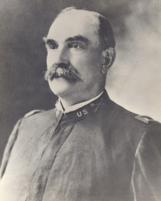
Colonel Francis Moore
Feb.2,1901
Feb.2,1901
THE FIRST UNIFORM
The headgear is referred to as a "campaign hat." It resembled a fedora with a crease down the middle of the crown. The shirt was made of dark blue chambray and the trousers were a buff-colored khaki with canvas leggings over low cut boots. A dark blue coat was used for dress occasions while a khaki coat was issued for field use. When mounted, the trooper wore brass rowel spurs and gauntlets (riding gloves). His holstered .38 caliber double action Colt revolver hung opposite a Model 1860 Light Cavalry Saber on a canvas "Mills" belt that held double rows of cartridges for his rifle. Slung from his saddle was a tin cup, a flat circular canteen, a blue blanket, and the famous smokeless powder Krag-Jorgensen magazine fed carbine.
he typical soldier began his day with "Stable Call" at 0500 hrs. Tasked with caring for his mount before addressing his own needs, the Trooper rubbed down, fed and exercised his horse. Next came routine with which soldiers of today can readily identify. This involved close order drill, athletics, guard duty, and honing the skills of scouting and patrolling. Afternoons were devoted to mounted drill, one of which was known as the "Monkey Drill." This maneuver required the Trooper to ride bareback hands free while putting his horse through various maneuvers. The pay of the 11th Cavalry soldier in the early 1900's was $13.00 a month for a six-day workweek. Sunday was a day off when Troopers received mounted passes that permitted riding through the countryside.
The headgear is referred to as a "campaign hat." It resembled a fedora with a crease down the middle of the crown. The shirt was made of dark blue chambray and the trousers were a buff-colored khaki with canvas leggings over low cut boots. A dark blue coat was used for dress occasions while a khaki coat was issued for field use. When mounted, the trooper wore brass rowel spurs and gauntlets (riding gloves). His holstered .38 caliber double action Colt revolver hung opposite a Model 1860 Light Cavalry Saber on a canvas "Mills" belt that held double rows of cartridges for his rifle. Slung from his saddle was a tin cup, a flat circular canteen, a blue blanket, and the famous smokeless powder Krag-Jorgensen magazine fed carbine.
he typical soldier began his day with "Stable Call" at 0500 hrs. Tasked with caring for his mount before addressing his own needs, the Trooper rubbed down, fed and exercised his horse. Next came routine with which soldiers of today can readily identify. This involved close order drill, athletics, guard duty, and honing the skills of scouting and patrolling. Afternoons were devoted to mounted drill, one of which was known as the "Monkey Drill." This maneuver required the Trooper to ride bareback hands free while putting his horse through various maneuvers. The pay of the 11th Cavalry soldier in the early 1900's was $13.00 a month for a six-day workweek. Sunday was a day off when Troopers received mounted passes that permitted riding through the countryside.
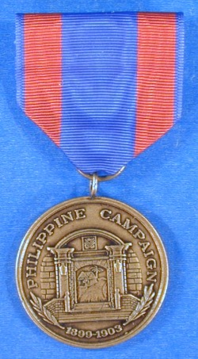
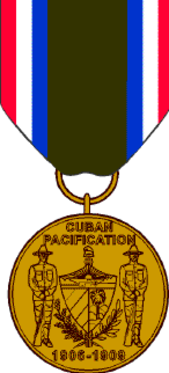
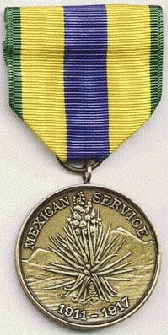
Howze's War Diary - 5 May 1916
5 May 1916 report to General Pershing: "We made an over-night march to Ojo Azules, distance thirty-six miles. Reached here at 5:45 a.m. unfortunately one-half hour after daylight. We surprised Julia Acosta, Cruz Domingues and Antonio Angel; jumped them. Had a running fight for two hours. Drove their bands into the hills between here and Carichic. Killed forty-two verified by officers; captured several and some fifty to seventy-one ponies and mules. It is believed that we killed Angel, although identification not completed. We rescued a Carranza lieutenant and four soldiers just before they were to be shot. We followed the enemy, consisting of about 140, until our horses were wholly exhausted, but the chase did not stop until the enemy’s left flank had been broken up entirely. In fact, those who escaped us did so as individuals. Our discovery was by Villista herd guards, which fired at our Indians, and alarmed the enemy, which ran pell mell, firing at us in their flight. The remarkable part is although the clothing of several of our men was hit; not a single man was wounded, thanks to the utter surprise and confusion of the enemy. We lost three or four horses. It is needless to say that officers and men behaved as would be expected."
The 11th Cavalry withdrew from Mexico on 5 February 1917; five days after Germany resumed a policy of unrestricted submarine warfare against American shipping on 31 January.
5 May 1916 report to General Pershing: "We made an over-night march to Ojo Azules, distance thirty-six miles. Reached here at 5:45 a.m. unfortunately one-half hour after daylight. We surprised Julia Acosta, Cruz Domingues and Antonio Angel; jumped them. Had a running fight for two hours. Drove their bands into the hills between here and Carichic. Killed forty-two verified by officers; captured several and some fifty to seventy-one ponies and mules. It is believed that we killed Angel, although identification not completed. We rescued a Carranza lieutenant and four soldiers just before they were to be shot. We followed the enemy, consisting of about 140, until our horses were wholly exhausted, but the chase did not stop until the enemy’s left flank had been broken up entirely. In fact, those who escaped us did so as individuals. Our discovery was by Villista herd guards, which fired at our Indians, and alarmed the enemy, which ran pell mell, firing at us in their flight. The remarkable part is although the clothing of several of our men was hit; not a single man was wounded, thanks to the utter surprise and confusion of the enemy. We lost three or four horses. It is needless to say that officers and men behaved as would be expected."
The 11th Cavalry withdrew from Mexico on 5 February 1917; five days after Germany resumed a policy of unrestricted submarine warfare against American shipping on 31 January.
THE ZIMMERMAN TELEGRAM
International Intrigue affects the 11th Cavalry
1 March 1917 saw the publication of a German memorandum proposing a defensive alliance with Mexico in case of war between Germany and the United States with the proviso "...that Mexico is to recover the lost territory in New Mexico, Texas and Arizona..." which caused a wave of American outrage. Alfred Zimmerman, German Foreign Secretary, had sent the coded message on 19 January, which also contained the suggestion that Mexico urge Japan to join the Central Powers, to von Eckhardt, the German Minister to Mexico. British Naval Intelligence intercepted and decoded it, giving a copy to the U.S. Ambassador to Britain on 24 February. After verification, it was released to the press 1 March. At the time, the British Navy had the German merchant fleet bottled up in the Gulf of California port of Santa Rosalia.
The United States’ declaration of war on Germany, enacted by Congress on 6 April 1917, found the Regiment pausing at Ft. Bliss, Texas as part of a provisional First Cavalry Division. Due to the threat outlined in the Zimmerman telegram and the proximity of the German merchant fleet, a detachment of the 11th was stationed on the border at Camp John Beacom in Calexico, California (nearest border crossing to the German fleet) while another was stationed in the Campo area. These detachments continued border duty until 1920. Within a month new orders came and Colonel James B. Irwin (6th COLONEL OF THE REGIMENT) led the remainder of the Regiment back to Chickamauga Park, Georgia, near Ft. Oglethorpe. The next two years saw various elements of the 11th Cavalry scattered throughout the South and West.
International Intrigue affects the 11th Cavalry
1 March 1917 saw the publication of a German memorandum proposing a defensive alliance with Mexico in case of war between Germany and the United States with the proviso "...that Mexico is to recover the lost territory in New Mexico, Texas and Arizona..." which caused a wave of American outrage. Alfred Zimmerman, German Foreign Secretary, had sent the coded message on 19 January, which also contained the suggestion that Mexico urge Japan to join the Central Powers, to von Eckhardt, the German Minister to Mexico. British Naval Intelligence intercepted and decoded it, giving a copy to the U.S. Ambassador to Britain on 24 February. After verification, it was released to the press 1 March. At the time, the British Navy had the German merchant fleet bottled up in the Gulf of California port of Santa Rosalia.
The United States’ declaration of war on Germany, enacted by Congress on 6 April 1917, found the Regiment pausing at Ft. Bliss, Texas as part of a provisional First Cavalry Division. Due to the threat outlined in the Zimmerman telegram and the proximity of the German merchant fleet, a detachment of the 11th was stationed on the border at Camp John Beacom in Calexico, California (nearest border crossing to the German fleet) while another was stationed in the Campo area. These detachments continued border duty until 1920. Within a month new orders came and Colonel James B. Irwin (6th COLONEL OF THE REGIMENT) led the remainder of the Regiment back to Chickamauga Park, Georgia, near Ft. Oglethorpe. The next two years saw various elements of the 11th Cavalry scattered throughout the South and West.
THE QUIET YEARS
On 9 July 1919, the main body of the Regiment departed Ft. Meyer, Virginia on a transcontinental trek to a new duty station at the Presidio of Monterey, California. Second and Third Squadrons, whose troops had been scattered throughout Georgia, Wyoming, and California, soon rejoined the HQ. Here the Regiment remained for over two decades, during the "Quiet Years."
Presidio duties included exercising horses on the beaches of Monterey, extended war maneuvers in the forests and deserts of California and summer training of ROTC personnel at Fort Lewis, Washington. In the 1930's, running the Citizen's Military Training Corps (CMTC) Program in Monterey was an additional requirement. In the comparatively genteel Army of the 1920's and 1930's, the Regiment's spare time was filled with unit competitions in polo and horsemanship.
On 9 July 1919, the main body of the Regiment departed Ft. Meyer, Virginia on a transcontinental trek to a new duty station at the Presidio of Monterey, California. Second and Third Squadrons, whose troops had been scattered throughout Georgia, Wyoming, and California, soon rejoined the HQ. Here the Regiment remained for over two decades, during the "Quiet Years."
Presidio duties included exercising horses on the beaches of Monterey, extended war maneuvers in the forests and deserts of California and summer training of ROTC personnel at Fort Lewis, Washington. In the 1930's, running the Citizen's Military Training Corps (CMTC) Program in Monterey was an additional requirement. In the comparatively genteel Army of the 1920's and 1930's, the Regiment's spare time was filled with unit competitions in polo and horsemanship.
THE GREAT PRESIDIO OIL FIRE OF 1924
At 1000 hours on September 14, 1924, the 11th Cavalry once again found itself in a fight. However, this time there were no bullets involved. The Presidio of Monterey was located right next to the Tidewater-Associated Marine Terminal, an oil storage facility. One of the oil storage tanks had been struck by lightning and set on fire. The fires in the wooden oil storage tanks were soon found to be almost impossible to control and the fire spread. Those warehouses closest to the fire contained grain and hay for the horses of the Regiment. The Army began to evacuate these warehouses and the work was completed just 10 minutes before the first oil tank exploded, covering the buildings with burning oil. As the burning tanks collapsed, rivers of burning oil flowed down the streets towards Monterey Bay. The heat from the fires became so intense that people several hundred feet away were burned.
Troopers fought the fires from behind sections of wooden fencing used as shields against the heat. Ladders were placed up against the sides of the burning tanks and troopers were ordered up them to spray water directly into the tanks. Many of these troopers died when the tanks collapsed and they were thrown into the burning oil.
Five days later, when the fire had finally burning itself out, it was found that 26 men were missing from the rolls and several hundred were injured. (Through the Army Memorial Program, many streets of Monterey, California, bear the names of the men who died fighting the fire. The bravery of these troopers is still remembered today, for if the oil had been allowed to flow down onto the town of Monterey and the many wooden structures, a greater number of loss of life and property would have most certainly been greater if it was not for the 11th Cavalry.
LESSONS LEARNED: With this and other similar above ground oil storage tanks fires, lessons were learned, that have affected the oil storage procedures industry wide.
That is, due to the fixed roofing and with repeated drainage/refilling; would naturally generate spacing between the oil and roofing unit. Vapors would develop and it is this, that most believed actually ignited, when the lighting struck. Lighting rods are of little value in these situations. When rainwater or the fire extinguishing water would land on top of the oil, this in time would descend as oil being lighting then water. With the tempter of the burring oil began reaching 212 degrees, the water converts to vapor expanding rapidly thus causing eruption of hot boiling burning oil.
This was not a familiar concept to the troopers who were working in good faith they treated the fire as a “wood burning fire” and continued to spray water onto the tanks hoping to cool the metal/wood casing enough to contain the oil. As the heat would transfer from one tank unit across to an adjacent unit that too would reach a tempter causing that unit to likewise explode, which lead to more loss of life.
Any water accumulated from previous rains that became covered with repeated “drainage/refilling of oil” generated a layering of oil-water-oil etc., when heated, expands and explodes or in this case, oil boiled up and over the sides of the containers. There are several accounts of the storage tank casings becoming too hot and collapsing inward tossing the troopers into the vat of burning oil.
Major lesson learned is that now the “tops” of these storage units are a floating top that does not allow the collection of vapors, distance between tanks has extended, a massive earth works have been constructed to contain the total oil within the storage unit in a designated area thus preventing expansion of the burning oil over to other units.
At 1000 hours on September 14, 1924, the 11th Cavalry once again found itself in a fight. However, this time there were no bullets involved. The Presidio of Monterey was located right next to the Tidewater-Associated Marine Terminal, an oil storage facility. One of the oil storage tanks had been struck by lightning and set on fire. The fires in the wooden oil storage tanks were soon found to be almost impossible to control and the fire spread. Those warehouses closest to the fire contained grain and hay for the horses of the Regiment. The Army began to evacuate these warehouses and the work was completed just 10 minutes before the first oil tank exploded, covering the buildings with burning oil. As the burning tanks collapsed, rivers of burning oil flowed down the streets towards Monterey Bay. The heat from the fires became so intense that people several hundred feet away were burned.
Troopers fought the fires from behind sections of wooden fencing used as shields against the heat. Ladders were placed up against the sides of the burning tanks and troopers were ordered up them to spray water directly into the tanks. Many of these troopers died when the tanks collapsed and they were thrown into the burning oil.
Five days later, when the fire had finally burning itself out, it was found that 26 men were missing from the rolls and several hundred were injured. (Through the Army Memorial Program, many streets of Monterey, California, bear the names of the men who died fighting the fire. The bravery of these troopers is still remembered today, for if the oil had been allowed to flow down onto the town of Monterey and the many wooden structures, a greater number of loss of life and property would have most certainly been greater if it was not for the 11th Cavalry.
LESSONS LEARNED: With this and other similar above ground oil storage tanks fires, lessons were learned, that have affected the oil storage procedures industry wide.
That is, due to the fixed roofing and with repeated drainage/refilling; would naturally generate spacing between the oil and roofing unit. Vapors would develop and it is this, that most believed actually ignited, when the lighting struck. Lighting rods are of little value in these situations. When rainwater or the fire extinguishing water would land on top of the oil, this in time would descend as oil being lighting then water. With the tempter of the burring oil began reaching 212 degrees, the water converts to vapor expanding rapidly thus causing eruption of hot boiling burning oil.
This was not a familiar concept to the troopers who were working in good faith they treated the fire as a “wood burning fire” and continued to spray water onto the tanks hoping to cool the metal/wood casing enough to contain the oil. As the heat would transfer from one tank unit across to an adjacent unit that too would reach a tempter causing that unit to likewise explode, which lead to more loss of life.
Any water accumulated from previous rains that became covered with repeated “drainage/refilling of oil” generated a layering of oil-water-oil etc., when heated, expands and explodes or in this case, oil boiled up and over the sides of the containers. There are several accounts of the storage tank casings becoming too hot and collapsing inward tossing the troopers into the vat of burning oil.
Major lesson learned is that now the “tops” of these storage units are a floating top that does not allow the collection of vapors, distance between tanks has extended, a massive earth works have been constructed to contain the total oil within the storage unit in a designated area thus preventing expansion of the burning oil over to other units.
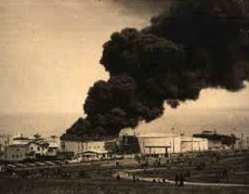
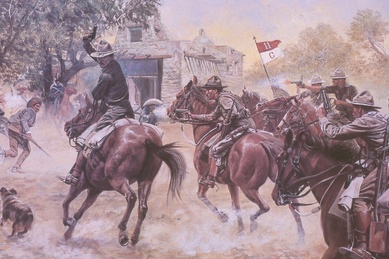
THE 11TH CAVALRY "GOES HOLLYWOOD"
During the inter-war period, Hollywood secured the 11th Cavalry to make war movies. The Regiment was involved in the making of two motion pictures, "Troopers Three" (1929) and "Sergeant Murphy" (1937). The latter starred a promising young actor in his second film by the name of Ronald Reagan, himself an Army Reserve Cavalryman in Troop B, 322nd Cavalry. On May 25, 1937, he was appointed a second lieutenant in the Officers' Reserve Corps of the Cavalry. Ronald Reagan was the last US President who served as a horse mounted cavalryman and the only one to "serve" with the 11th Cavalry Regiment.
During the inter-war period, Hollywood secured the 11th Cavalry to make war movies. The Regiment was involved in the making of two motion pictures, "Troopers Three" (1929) and "Sergeant Murphy" (1937). The latter starred a promising young actor in his second film by the name of Ronald Reagan, himself an Army Reserve Cavalryman in Troop B, 322nd Cavalry. On May 25, 1937, he was appointed a second lieutenant in the Officers' Reserve Corps of the Cavalry. Ronald Reagan was the last US President who served as a horse mounted cavalryman and the only one to "serve" with the 11th Cavalry Regiment.
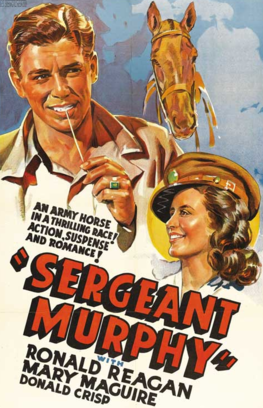
THE GOLDEN GATE BRIDGE
The Regiment participated in many ceremonies, such as marking the opening of the Golden Gate Bridge at San Francisco on 1 June 1937. The guidon for 'D' Troop was carried by Pvt. Hubert Brown on that day and has been donated by him to the Regiment. The guidon was entrusted into his care as the 'D' Troop guidon bearer commencing in 1935 until he left the Regiment in 1940.
The Regiment participated in many ceremonies, such as marking the opening of the Golden Gate Bridge at San Francisco on 1 June 1937. The guidon for 'D' Troop was carried by Pvt. Hubert Brown on that day and has been donated by him to the Regiment. The guidon was entrusted into his care as the 'D' Troop guidon bearer commencing in 1935 until he left the Regiment in 1940.
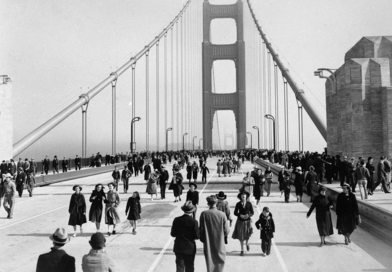
The 1920's and 1930's saw the gradual introduction of armored cars, trucks and motorcycles to the Regiment, supplementing the traditional horse, wagon and pack mules. Scout cars were accepted in 1935 with the later M3A1 becoming the pre-war mainstay. Special built tractor-trailers were capable of rapidly transporting eight fully equipped Troopers with their horses to any staging point. (It was also in the late 1930's that the Regiment was issued the Garand M1 to replace the venerable Springfield M1903 rifle.)
In the mid-1930's the US Army purchased European military equipment for testing purposes. One such item was this horse drawn munitions wagon recently recovered near Camp Locket, where the Regiment was stationed. It has been restored to the original German Army forest green color just as it was used by the 11th Cavalry. The Regiment added the distinctive crossed sabers of the Cavalry.
Field maneuvers, large-scale exercises and an occasional search and rescue mission in the mountains of Southern California gave the 11th Cavalry a unique training opportunity among the Army’s Cavalry Regiments. They were able to evaluate, under as-near-to battlefield conditions as possible, the efficiency of the horse in the modern army. One such rescue mission incorporated nearly every vehicle in the regimental inventory. Using motorcycle squads, Bantam scout cars (Jeeps), the M3A1 scout car, 11⁄2-ton trucks and the age-old horse now deployed by tractor-trailer, the Troopers combed rugged mountains for two lost infantrymen. The lessons learned in the coordination of movement and the maneuverability of the various components in the successful mission were forwarded for study to Washington D.C. The information was taken to heart. Virtually every single country entering WWII had horse mounted supply, artillery and cavalry units in combat.
Over a dozen of those countries still fielded them at war’s end. In April 1945, the 4th German Cavalry Division alone surrendered 16,000 horse mounted soldiers.
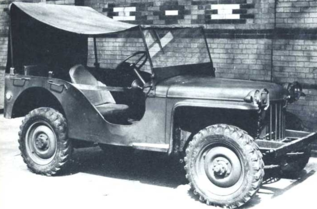
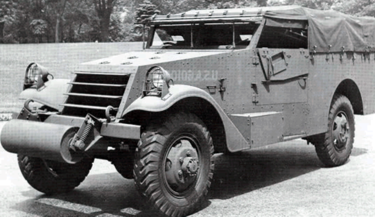


HISTORY
Pg 2
Pg 2
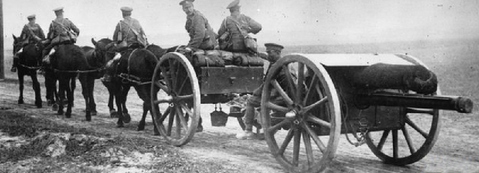
"HORSE TO HORSEPOWER"
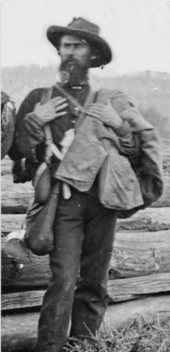
HISTORY Pg 2
